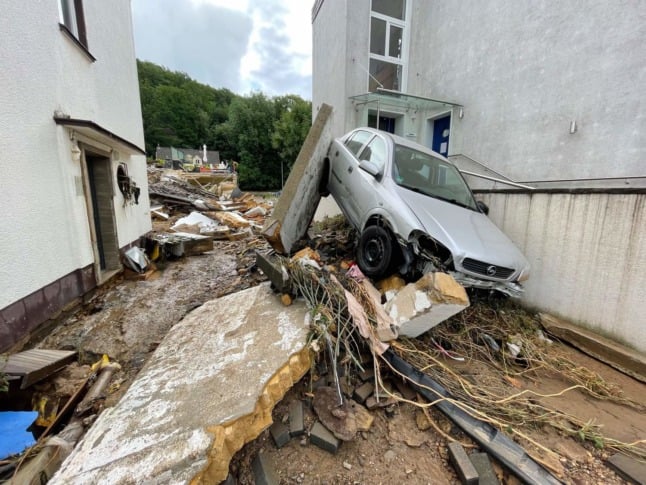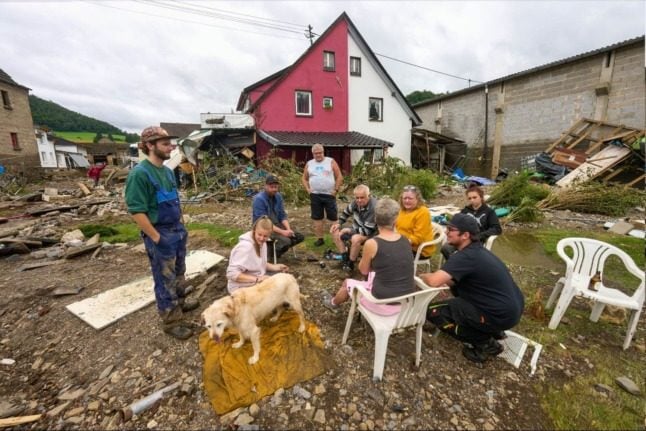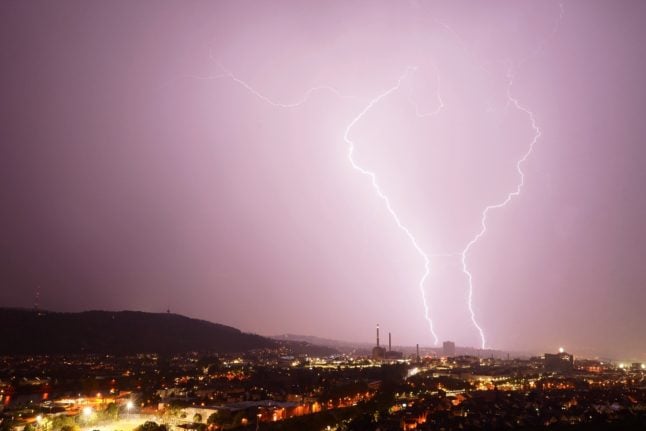The scale of the catastrophe began to unfold throughout the day as the death toll rose. Police on Thursday night said at least 59 people had died and more were missing.
Desperate residents sought refuge on the roofs of their homes as helicopters circled above to rescue them from the rising waters.
The states of Rhineland-Palatinate and North Rhine-Westphalia (NRW) were worst hit by the heavy rainstorms which have caused rivers to burst their banks and threatened to bring down further homes.
LATEST: Floods leave several dead and many missing in western Germany
Pensioner Annemarie Müller, 65, looking out at her flooded garden and garage from her balcony, said her town of Mayen, Rhineland-Palatinate, had been completely unprepared for the destruction.
“Nobody was expecting this, where did all this rain come from? It’s crazy,” she told AFP.
“It made such a loud noise and given how fast it came down we thought it would break the door down.”
NRW state leader Armin Laschet cancelled a party meeting in Bavaria to visit the scene in his state, Germany’s most populous.
“The situation is alarming,” Laschet told German daily Bild at one of the crisis areas, “People are still missing.
“I’ve talked to many residents who’ve lost everything virtually overnight.”

Laschet promised “quick help” to those who needed it, saying that Germany “will do everything” to support people.
“We will stand by the towns and people who’ve been affected,” Laschet, wearing rubber boots and a white shirt, told reporters in the town of Hagen.
IN PICTURES: Torrential rain leaves trail of destruction across western Germany
Andreas Friedrich, of the German Weather Service said some areas hadn’t seen this much rainfall “in 100 years”.
Chancellor Angela Merkel, on a visit to Washington, said she was “shocked” by the humanitarian “disaster”, calling it a “tragedy” for the nation.
She vowed that the government would do “everything in its power to, under the most difficult circumstances, save lives, prevent danger and ease suffering”.
Images of Germany’s “catastrophe”, as chancellor Merkel called the severe flooding that has hit western Germany, killing dozens pic.twitter.com/YPnjkwvE3U
— Thomas Sparrow (@Thomas_Sparrow) July 15, 2021
“We have never seen such a catastrophe, it is truly devastating,” Rhineland-Palatinate state premier Malu Dreyer said in a parliament session.
“There are dead, there are missing, there are many who are still in danger,” Dreyer said solemnly. “It’s really devastating.” Entire towns are flooded, she said, adding that houses “floated away”.
She said police helicopters were out trying to rescue people. Families have been struggling to reach people because many of the mobile phone networks are down.
Which areas are worst affected?
This situation is still developing but here’s what we know so far. In North Rhine-Westphalia at least 31 people have died, while neighbouring Rhineland-Palatinate said nine more deaths were likely in addition to 19 recovered in the region around the western town of Ahrweiler alone, after the river Ahr burst its banks.
The small Eifel village of Schuld was hit hard. The village with about 700 inhabitants lies close to the state border with NRW. Floods swept away six houses there. Four people are reported to have died in Schuld.
A dramatic rescue operation got underway on Wednesday night as dozens of people scrambled to try and reach safety on their roof. More houses are at risk of collapse, authorities said Thursday.
In the Eifel district of Bitburg-Prüm, several people got trapped in their homes by the deluge of water. There have been no reports of deaths, injuries or missing people so far. A district spokesman reported at least one collapsed house.
In the district of Euskirchen in the south of North Rhine-Westphalia, at least 15 died in the severe storm, according to initial reports. In several places, the situation was still critical on Thursday afternoon. “People are being rescued,” the district administration reported.
In some areas, there is no access to villages and communication is largely down.
Some areas, including Bad Münstereifel have been devastated by the extreme rainfall.
There is also severe flooding in other parts of North Rhine-Westphalia, particularly Solingen and Hagen. Parts of Saarland are also affected.
Police said two firefighters died on duty – one in Sauerland, north of Bonn, while another firefighter died in NRW.




 Please whitelist us to continue reading.
Please whitelist us to continue reading.
Member comments